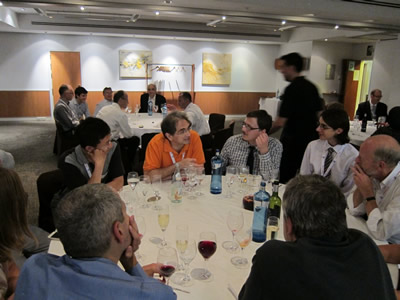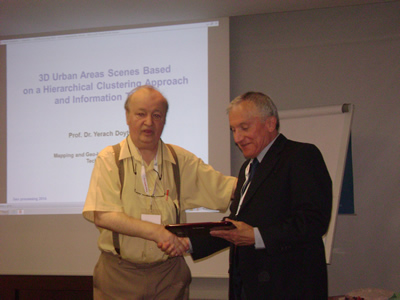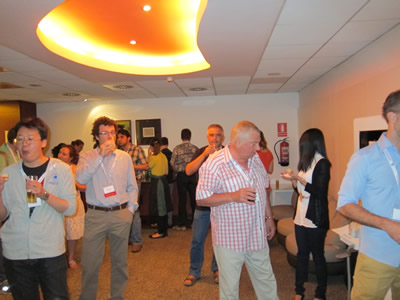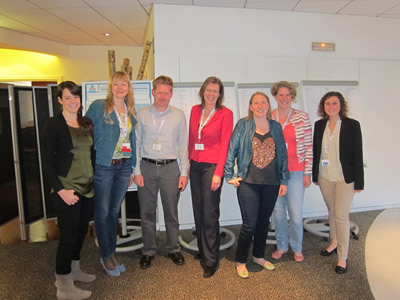AIVTS 2025 - The First International Conference on AI-enabled Unmanned Autonomous Vehicles and Internet of Things for Critical Services
October 26, 2025 - October 30, 2025
AIVTS 2025: Call for Papers
Onsite and Online Options: In order to accommodate various situations, we are offering the option for either physical presence or virtual participation (pdf slides or pre-recorded videos).
The rapid advances and widespread adoption of the Internet of Things (IoT) have promoted a revolution in communication and processing technology and offered a very large range of applications and services. Multi emerging directions in systems design and implementation are developed. IoT systems have advanced greatly in the past few years, becoming intelligent, especially with the support of Artificial Intelligence (AI) and Machine Learning (ML).
In parallel, Unmanned Autonomous Vehicles (UAVs) technology (aerial drones, terrestrial, underearth, and underwater), enabled new applications in various areas such as energy, agriculture, transportation, avionic, health, military, surveillance and monitoring, delivery, critical missions and others. Multi-UAVs solutions allowed systems to collaborate and complete missions more efficiently and economically. One particular UAV domain concerns both autonomy and automation, because of challenges of secure and reliable connectivity and privacy preservation. Integration of AI/ML in UAVs can lead to high growth in the field, by improving safety and efficiency. ML algorithms can enable UAVs to make real-time decisions in complex environments and reach the optimal solution, aiming to meet the mission requirements.
IoT-based UAV networks is a novel emerging field, that combines the UAV network dynamic capabilities with the IoT power. Such solutions can be powerful and highly effective for mission critical services. Cooperation with edge computing can bring additional power of UAV/IoT systems. However, using advanced technologies on sensing, edge computing, computing, and data processing and interpretation, while AI/ML-based, requires further research work of appropriate models, protocols, validation, and also considerations of human-centric global issues (climate, energy, pollution, battlefield, wellness). The advent of AI/ML-based approaches for guiding and orchestrating the interpretation of visual patterns, optimizing path, real-time multi-prong decisions and complex and dynamic systems, led to a powerful triad: AI-IoT-UAV.
AIVTS conference focuses on advanced topics on integrating IoT, UAV and AI/ML and target solutions for dynamic and critical systems. AIVTS event series considers the research work combining synergistic needs.
We solicit both academic, research, and industrial contributions. We welcome technical papers presenting research and practical results, position papers addressing the pros and cons of specific proposals, such as those being discussed in the standard fora or in industry consortia, survey papers addressing the key problems and solutions on any of the above topics short papers on work in progress, and panel proposals.
Industrial presentations are not subject to the format and content constraints of regular submissions. We expect short and long presentations that express industrial position and status.
Tutorials on specific related topics and panels on challenging areas are encouraged.
The topics suggested by the conference can be discussed in term of concepts, state of the art, research, standards, implementations, running experiments, applications, and industrial case studies. Authors are invited to submit complete unpublished papers, which are not under review in any other conference or journal in the following, but not limited to, topic areas.
All topics and submission formats are open to both research and industry contributions.
AIVTS 2025 conference tracks:
AI-Cognition for UAV/IoT-based critical services and applications
AI-based cognition and decision making in IoT/ UAV systems
AI and Autonomy in UAVs based on real-time data
Autonomous vehicles and smart city infrastructure with Edge AI computing
Self-learning IoT systems and UAVs
Swarm intelligence applications
Neuromorphic computing for IoT devices and UAVs
AI-based regulatory frameworks for IoT and UAV
AI and IoT convergence in Industry 4.0
Planned complex services for healthcare, urban planning, and emergency services
AI-based orchestration of IoT & UAV for critical systems
UAV-IoT-enabled sensing and tracking
Environmental monitoring
Disaster handling
Search and Rescue
Mapping and surveying
Precision agriculture
Emerging applications of 3D networks
Unmanned Aerial Vehicles (drones)
Single and Multi-UAV networks: architectures, topologies
UAV-related protocols and mechanisms
UAV-based sensor networks
UAV integration in cellular networks 5G, 6G
UAV-enabled edge computing: architectures and protocols
Mobility aspects
Micro flying systems
Standards and regulations
Ground autonomous vehicles (robots)
IoT sensors for robot perception
IoT-enabled robot navigation and mapping
AI-based path optimization and scheduling
AI-based orchestration of Industrial robots
IoT data analytics for robots
Robot swarms and IoT communication
UAV Applications for Critical Missions and Services
Express shipping and delivery
Disaster management: gathering information or supplying essentials
Storm tracking and forecasting hurricanes and tornadoes
Image processing, computer vision, and pattern recognition
Law enforcement and border control surveillance
UAVs for search and rescue operations
Forest fires related missions
Safety inspections and surveillance
UAV Operations
Wireless communication technologies for UAV
Routing, path planning, scheduling and tracking
Resource allocation in UAV systems
Mobility-related protocols and procedures
Cooperative control of UAV swarms
VLOS, EVLOS, and BVLOS operations of UAVs
Security protocols and mechanisms in UAV networks
Optimal UAV deployment strategies
Intelligent orchestration of UAV communication and computing
Autonomous sensing via UAVs
AI/Machine learning (DL, RL, DRL, etc.) for UAV communications, management & control and for services
UAV Swarm intelligence
AI-based coordination in multi-UAV systems
Regulations and guidelines
UAV-related energy
Scalable wireless charging platforms for UAV networks
Battery and energy management in UAV networks
Energy-efficient UAV communications
AI-based prediction of drone energy consumption in flight
Internet of Things
IoT – architectural evolution
IoT applications for critical missions
IoT communication technologies
IoT integration in cellular networks 5G, 6G
Fog/Edge-computing-driven IoT
IoT-enabled tracking techniques
Security and privacy in IoT systems
Standards and regulations
Intelligent and AI-based IoT
AI-based applications in IoT
UAV and IoT Cooperation
UAV and IoT Integration: use cases, applications and challenges
UAV/IoT system architectures
UAV enabled networks for IoT
Physical and access layers topics in UAV-enabled IoT
UAVs equipped with IoT sensors
IoT- UAV management and control
IoT sensing for green and sustainable UAV-based applications
IoT for real-time UAV data transmission
UAV swarms for IoT deployments
Network and information security for UAV-enabled IoT
Quality of Service in UAV-enabled IoT
Energy-related topics in UAV-enabled IoT
Deadlines:
Submission | Jul 25, 2025 |
Notification | Aug 27, 2025 |
Registration | Sep 09, 2025 |
Camera ready | Sep 21, 2025 |
Deadlines differ for special tracks. Please consult the conference home page for special tracks Call for Papers (if any).
INSTRUCTION FOR THE AUTHORS
Authors of selected papers will be invited to submit extended versions to one of the IARIA Journals.
Publisher: XPS (Xpert Publishing Services)
Archived: ThinkMindTM Digital Library (free access)
Prints available at Curran Associates, Inc.
How to submit to appropriate indexes.
Only .pdf or .doc files will be accepted for paper submission. All received submissions will be acknowledged via an automated system.
Contribution types
- regular papers [in the proceedings, digital library]
- short papers (work in progress) [in the proceedings, digital library]
- ideas: two pages [in the proceedings, digital library]
- extended abstracts: two pages [in the proceedings, digital library]
- posters: two pages [in the proceedings, digital library]
- posters: slide only [slide-deck posted on www.iaria.org]
- presentations: slide only [slide-deck posted on www.iaria.org]
- demos: two pages [posted on www.iaria.org]
FORMATS
Only .pdf or .doc files will be accepted for paper submission. All received submissions will be acknowledged via an automated system.
Final author manuscripts will be 8.5" x 11", not exceeding 6 pages; max 4 extra pages allowed at additional cost.
Helpful information for paper formatting for MS Word can be found here.
There is a community provided LaTeX template: the CTAN package iaria (with full IARIA formatting rules, including IARIA citation style, but for providing citation style it is tightly bound to pdflatex+biblatex+biber). In addition, there is also iaria-lite (not bound to pdflatex+biblatex+biber, but compatible with any TeX stack; thus, it cannot provide the IARIA citation formattings, but only the titlepage and content-related IARIA formatting rules). Based on the iaria package, there is a minimal working example as Overleaf template. When you are using the LaTeX templates, please still adhere to the additional editorial rules.
Slides-based contributions can use the corporate/university format and style.
Your paper should also comply with the additional editorial rules.
Once you receive the notification of contribution acceptance, you will be provided by the publisher an online author kit with all the steps an author needs to follow to submit the final version. The author kits URL will be included in the letter of acceptance.
We would recommend that you should not use too many extra pages, even if you can afford the extra fees. No more than 2 contributions per event are recommended, as each contribution must be separately registered and paid for. At least one author of each accepted paper must register to ensure that the paper will be included in the conference proceedings and in the digital library, or posted on the www.iaria.org (for slide-based contributions).
CONTRIBUTION TYPE
Regular Papers (up to 6-10 page article -6 pages covered the by regular registration; max 4 extra pages allowed at additional cost- ) (oral presentation)
These contributions could be academic or industrial research, survey, white, implementation-oriented, architecture-oriented, white papers, etc. They will be included in the proceedings, posted in the free-access ThinkMind digital library and sent for indexing. Please submit the contributions following the instructions for the regular submissions using the "Submit a Paper" button and selecting the appropriate contribution type. 12-14 presentation slides are suggested.
Short papers (work in progress) (up to 4 pages long) (oral presentation)
Work-in-progress contributions are welcome. These contributions represent partial achievements of longer-term projects. They could be academic or industrial research, survey, white, implementation-oriented, architecture-oriented, white papers, etc. Please submit the contributions following the instructions for the regular submissions using the "Submit a Paper" button and selecting the contribution type as work in progress. Contributors must follow the conference deadlines, describing early research and novel skeleton ideas in the areas of the conference topics. The work will be published in the conference proceedings, posted in the free-access ThinkMind digital library and sent for indexing. For more details, see the Work in Progress explanation page. 12-14 presentation slides are suggested.
Ideas contributions (2 pages long) (oral presentation)
This category is dedicated to new ideas in their very early stage. Idea contributions are expression of yet to be developed approaches, with pros/cons, not yet consolidated. Ideas contributions are intended for a debate and audience feedback. Please submit the contributions following the instructions for the regular submissions using the "Submit a Paper" button and selecting the contribution type as Idea. Contributors must follow the conference deadlines, describing early research and novel skeleton ideas in the areas of the conference topics. The work will be published in the conference proceedings, posted in the free-access ThinkMind digital library and sent for indexing. For more details, see the Ideas explanation page. 12-14 presentation slides are suggested.
Extended abstracts (2 pages long) (oral presentation)
Extended abstracts summarize a long potential publication with noticeable results. It is intended for sharing yet to be written, or further on intended for a journal publication. Please submit the contributions following the instructions for the regular submissions using the "Submit a Paper" button and selecting the contribution type as Extended abstract. Contributors must follow the conference deadlines, describing early research and novel skeleton ideas in the areas of the conference topics. The work will be published in the conference proceedings, posted in the free-access ThinkMind digital library and sent for indexing. 12-14 presentation slides are suggested.
Posters (paper-based, two pages long) (oral presentation)
Posters are intended for ongoing research projects, concrete realizations, or industrial applications/projects presentations. The poster may be presented during sessions reserved for posters, or mixed with presentation of articles of similar topic. A two-page paper summarizes a presentation intended to be a POSTER. This allows an author to summarize a series of results and expose them via a big number of figures, graphics and tables. Please submit the contributions following the instructions for the regular submissions using the "Submit a Paper" button and selecting the contribution type as Poster Two Pages. Contributors must follow the conference deadlines, describing early research and novel skeleton ideas in the areas of the conference topics. The work will be published in the conference proceedings, posted in the free-access ThinkMind digital library and sent for indexing. 8-10 presentation slides are suggested. Also a big Poster is suitable, used for live discussions with the attendees, in addition to the oral presentation.
Posters (slide-based, only) (oral presentation)
Posters are intended for ongoing research projects, concrete realizations, or industrial applications/projects presentations. The poster may be presented during sessions reserved for posters, or mixed with presentation of articles of similar topic. The slides must have comprehensive comments. This type of contribution only requires a 8-10 slide-deck. Please submit the contributions following the instructions for the regular submissions using the "Submit a Paper" button and selecting the contribution type as Poster (slide-only). The slide-deck will be posted, post-event, on www.iaria.org.
8-10 presentation slides are suggested. Also a big Poster is suitable, used for live discussions with the attendees, additionally to the oral presentation.
Presentations (slide-based, only) (oral presentation)
These contributions represent technical marketing/industrial/business/positioning presentations. This type of contribution only requires a 12-14 slide-deck. Please submit the contributions following the submission instructions by using the "Submit a Paper" button and selecting the contribution type as Presentation (slide-only). The slide-deck will be posted, post-event, on www.iaria.org.
12-14 presentation slides are suggested.
Demos (two pages) [posted on www.iaria.org]
Demos represent special contributions where a tool, an implementation of an application, or a freshly implemented system is presented in its alfa/beta version. It might also be intended for thsoe new application to gather the attendee opinion. A two-page summary for a demo is intended to be. It would be scheduled in special time spots, to ensure a maximum attendance from the participants. Please submit the contributions following the submission instructions by using the "Submit a Paper" button and selecting the contribution type as Demos. The Demos paper will be posted, post-event, on www.iaria.org.
Tutorial proposals
Tutorials provide overviews of current high interest topics. Proposals should be for 2-3 hour long. Proposals must contain the title, the summary of the content, and the biography of the presenter(s). The tutorial slide decks will be posted on the IARIA site.
Please send your proposals to tutorial proposal
Panel proposals
The organizers encourage scientists and industry leaders to organize dedicated panels dealing with controversial and challenging topics and paradigms. Panel moderators are asked to identify their guests and manage that their appropriate talk supports timely reach our deadlines. Moderators must specifically submit an official proposal, indicating their background, panelist names, their affiliation, the topic of the panel, as well as short biographies. The panel slide deck will be posted on the IARIA site.
Please send your proposals to panel proposal









































